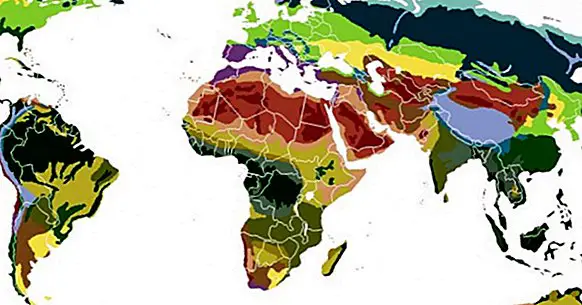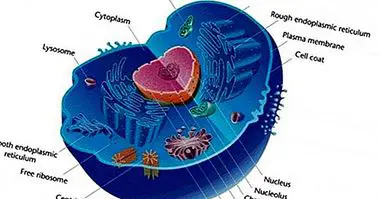The 9 types of biomes that exist in the world
How important is the environment! If you do not take care of it, you will end up losing the different natural landscapes that exist throughout the world , like forests, jungles or seas. Each environment presents some animals (fauna) and plants (flora) characteristic, that are related between them and with the climatic conditions (mainly temperature and precipitations), forming a small system, that is known as ecosystem.
The truth is that there are large areas in the world where a specific climate predominates and are inhabited by a similar fauna and flora that form small communities, that is, these territories are composed of different similar ecosystems. The set is what are called biomes. Exactly on this last we will speak in this article: the types of biomes .
- Related article: "The 15 most poisonous animals in the world"
The types of biomes
Defining the different types of biomes is not easy. There are many criteria for classification and throughout history have been emerging different methods for this, such as the Holdridge, Whittaker or the proposed by the World Wide Fund for Nature (WWF in its English acronym). Although in this article I will talk about the main biomes as they have been taught in a traditional way, it is good to keep this in mind.
1. Tundra
Located mainly in the northern hemisphere, in the fringe of the arctic circle , this terrestrial biome is characterized by a climate of low temperatures and rainfall, with short periods of favorable weather.
The soil is constantly permafrost , that is, freezing and thawing continuously, which causes it to be poor in nutrients and the flora that inhabits this biome is basically composed of plants with limited growth, such as grasses, mosses and lichens. As for the fauna, it highlights the presence of large mammals and migratory species.
2. Taiga
This biome is normally located in the northern hemisphere, in the northern belt. The climate that predominates consists of very cold winters and short summers, with rather scarce rainfall . On this occasion, the soil only freezes in winter, so it is not so poor in nutrients.
The remarkable flora is based on forests of coniferous trees (for example, the spruce). As for fauna, it consists of migratory species and animals that winter in cold seasons, such as the bear.
3. Deciduous forests
This type of biome is located in certain areas of the US, Europe, China and South America. The favorable time period is longer than the previous ones, although the winter is still freezing. The peculiarity of these forests is the soil rich in organic matter that comes from the decomposition of fallen leaves in autumn-winter.
The flora that makes up these forests is based on deciduous trees, that is, they lose their leaves in winter. The fauna is very varied, and migratory species and wintering animals continue to occur.
5. Steppes, meadows and pampas
The same biome receives different names depending on the continent where it is found: steppes in Eurasia, meadows in North America and pampas in South America. This natural environment is characterized by cold winters and hot summers, with periods of drought.
The flora that is adapted to this very seasonal biome, that is, winter rest, very active spring and water deficit in the middle of summer. Thus, It is dominated by grasses and perennial herbs (they do not lose the leaves). The fauna that inhabits it is either adapted to fluctuating resources or it is migratory.
6. Mediterranean forests
Mainly located around the Mediterranean Sea, this type of biome is also observed in California, Chile, Cape Town (South Africa) and southwestern Australia. The typical climate of these areas are moderate winters and warm summers, with precipitation in winter and spring, but with periods of summer drought.
The forests are formed by a single type of evergreen tree with drought resistance , such as oaks, cork oaks or oaks, along with shrubs and understory plants (which live under the shade of trees). The fauna that is observed are, mainly, forest species but not migratory, although some yes are wintering.
7. Rainforest
Distributed by South America (Amazonas), Africa (Congo) and Indonesia. It stands out for the absence of stations, having a constant and high temperature throughout the year and abundant rainfall.
It is the biome with the greatest biodiversity and complexity in the world, where more than 50% of the species reside. In the flora dominate the giant trees (more than 70m high), followed by all types of plants, including vines and palms. In the fauna Insects, arachnids, amphibians, reptiles and birds abound . Among the mammals are those of arboreal life, or the great ones who live their lives on the ground.
8. Desert
This type of biome is distributed throughout the world, being found in North America, South America, Africa, Asia and Australia. It is characterized by lack of precipitation and high erosion that suffers the soil by the wind, which makes life difficult. There can be both warm (Sahara) and cold (Gobi) deserts.
Both the flora and fauna that inhabits these biomes are adapted to these extreme conditions . Although scattered, the flora exists. Predominate drought-resistant plants such as xerophiles (Cactus). As for the fauna, small animals are common that have developed mechanisms to avoid the loss of moisture, such as the strategy of hiding underground during the day.
9. Aquatic biomes
Finally, it is worth mentioning aquatic biomes in a general way. In fact it is the one with the greatest presence in the world, since includes all oceans . This type of biome is divided into marine biomes (seas) and freshwater biomes (rivers).



















